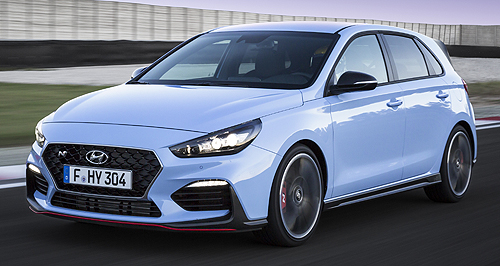Make / Model Search
Future models - Hyundai - i30 - NHyundai reveals its i30 N ‘corner rascal’First Hyundai N hot hatch revealed in Germany ahead of global roll-out this yearGallery Click to see larger images 13 Jul 2017 HYUNDAI has chosen hot-hatch heartland, Germany, to finally reveal the production version of its all-new i30 N – the first of a flock of high-performance cars from its new N skunkworks. A rival for front-wheel-drive hatches such as the Volkswagen Golf GTI and Ford Focus ST, the i30 N was shown at a global launch in Dusseldorf after a long and very public gestation, much of it at Germany’s famed Nurburgring. Official images reveal a subtle but stylish sports body treatment, complete with obligatory red highlights on items such as the front splitter, rear diffuser and brake callipers. Air openings at the front include brake cooling ducts, while a rear roof-mounted spoiler – complete with a race-style triangular brake light – helps to keep the car planted on its fat wheels. The new N logo – named after Hyundai’s Namyang research and development centre in South Korea and said to symbolise the shape of a chicane – is emblazoned on the grille and brake callipers. Hyundai says the main focus of the i30 N’s development has been on the fun factor, with its handling character described as “corner rascal”. Unveiling the new car, Hyundai’s executive vice-president of performance development Albert Biermann said the company’s new high-performance N models would cater to the needs of people “who love to have a smile on their face”. “That’s why we measure high-performance in BPM, heart beats per minute, instead of only RPM,” he said. Set to arrive in Australia before the end at this year with pricing potentially starting below $40,000, the five-door i30 N hatch will be joined next year by a similarly enhanced N-version of the upcoming five-door liftback i30 and – at a date to be fixed – and an even hotter all-wheel-drive hatchback based on the raunchy RN30 concept to go up against the cream of Euro hot hatches such as the VW Golf R, Renault Megane RS, Honda Civic Type R and Ford Focus RS. As expected, the i30 N will be offered with a 2.0-litre turbocharged four-cylinder petrol engine in two states of tune – 184kW/353Nm for the standard i30 N and 202kW/353Nm for the i30 N Performance – that propel the 1450kg hatch from zero to 100km/h in a claimed 6.4 and 6.2 seconds respectively. This puts it ahead of the Golf GTI’s 162kW/350Nm and 169kW/350Nm variants that cover the standing start sprint in 6.5 and 6.4 seconds. Unlike the GTI, the i30 N will only be available with a six-speed manual gearbox at launch, with an alternative eight-speed dual-clutch automatic transmission not expected to come on stream until 2019. Hyundai Motor Company Australia (HMCA) has yet to set pricing, but logic suggests the i30N will be priced below the $41,490 plus on-road costs Golf GTI and its $47,990 Performance Edition. When it comes, the i30N will be the only variant in the i30 range to come to Australia from Hyundai’s Czech Republic factory, at least until other N cars such as the liftback “coupe” go into production. Among the sporting features that set the N apart from its i30 brethren are launch control, rev-matching gearbox shift, electronically controlled adjustable suspension and a driving control system with five modes – Eco, Normal, Sport, N and N Custom. These modes control functions such as engine response, suspension settings, steering assistance, electronic stability control (ESC) and even the rev-matching gear-change system. The N setting ramps everything up to a Sports+ level that, apart from tightening all the settings, adds a crackling exhaust after-fire on turbo overrun. If you want more noise, the i30 N even comes with an electronic sound generator that produces “a sporty engine sound” from a gadget at the base of the windscreen. For thrill-seekers, the ESC can be switched off. Apart from extra power, the Performance version gets larger brakes, bigger 19-inch alloy wheels with Pirelli P-Zero tyres (the standard car has 18-inch alloys with Michelin rubber), as well as an electronically controlled limited-slip differential and variable exhaust valve system. The latter turns the racket from the twin exhausts “from normal to decidedly powerful”. To bolster body rigidity for high performance driving, an extra bar has been fitted across the body behind the rear seats. Sitting several millimetres lower than the standard i30, the N-version’s variable suspension can be adjusted for everyday commuting, sports driving or track days. If Hyundai’s Performance Blue exterior colour is not your preference, you can select from six others. Inside, the sports seats are available in a choice of two trims – leather/suede or cloth. The N logo is emblazoned on numerous items, including the steering wheel, gear knob and seats. A blue theme is carried through the cabin via stitching and markings on the gear knob and instruments.  Read more3rd of May 2017  Hyundai i30 N coupe confirmedFive-door fastback version of i30 N hot-hatchback gets Hyundai green flag2nd of May 2017  Driven: Hyundai refuses to give up i30 salesMore buyers to push upmarket with third-generation Hyundai i3012th of April 2017  Home ground advantage for Hyundai i30 NHot Hyundai i30 N set to make race debut at Nurburgring where it was developedAll future modelsi30 pricing
Motor industry news |
Click to shareHyundai modelsAll future modelsi30 pricing
Motor industry news |

































 Alfa Romeo
Alfa Romeo Abarth
Abarth Audi
Audi Aston Martin
Aston Martin BMW
BMW Bentley
Bentley Ferrari
Ferrari Chevrolet
Chevrolet Ford
Ford Fiat
Fiat GWM
GWM Foton
Foton Hyundai
Hyundai Honda
Honda Jaguar
Jaguar Isuzu
Isuzu Kia
Kia Jeep
Jeep Land Rover
Land Rover Lamborghini
Lamborghini Maserati
Maserati Lexus
Lexus McLaren
McLaren Mazda
Mazda Mercedes-Benz
Mercedes-Benz Mitsubishi
Mitsubishi Mini
Mini Peugeot
Peugeot Nissan
Nissan Ram
Ram Porsche
Porsche Rolls-Royce
Rolls-Royce Smart
Smart Skoda
Skoda Suzuki
Suzuki Subaru
Subaru Toyota
Toyota Tesla
Tesla Volvo
Volvo Zeekr
Zeekr







Facebook Twitter Instagram